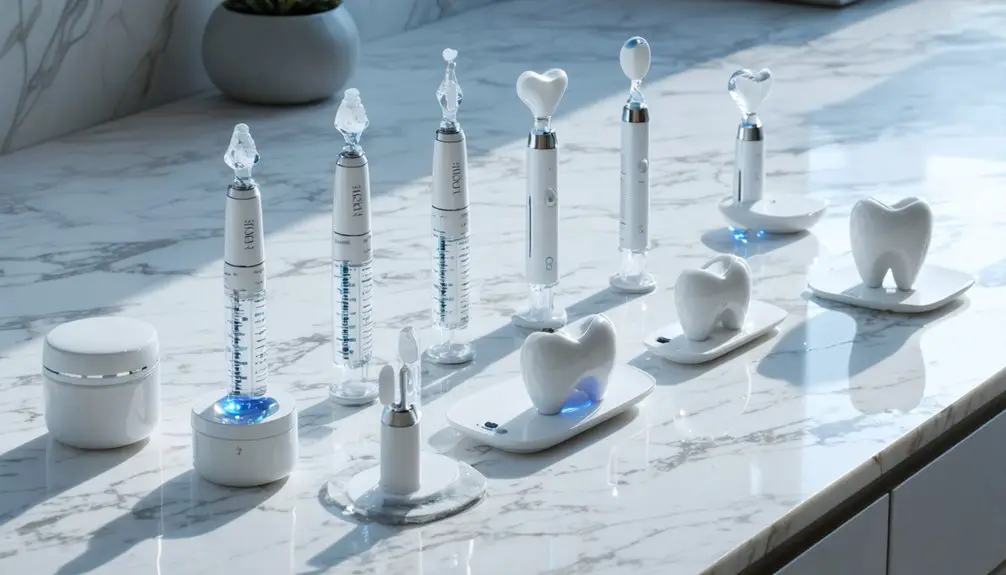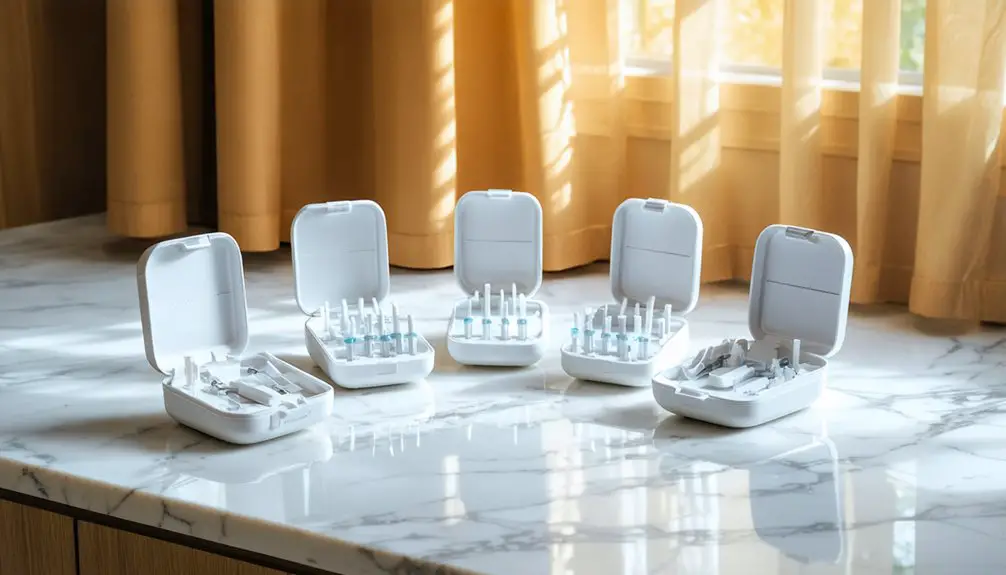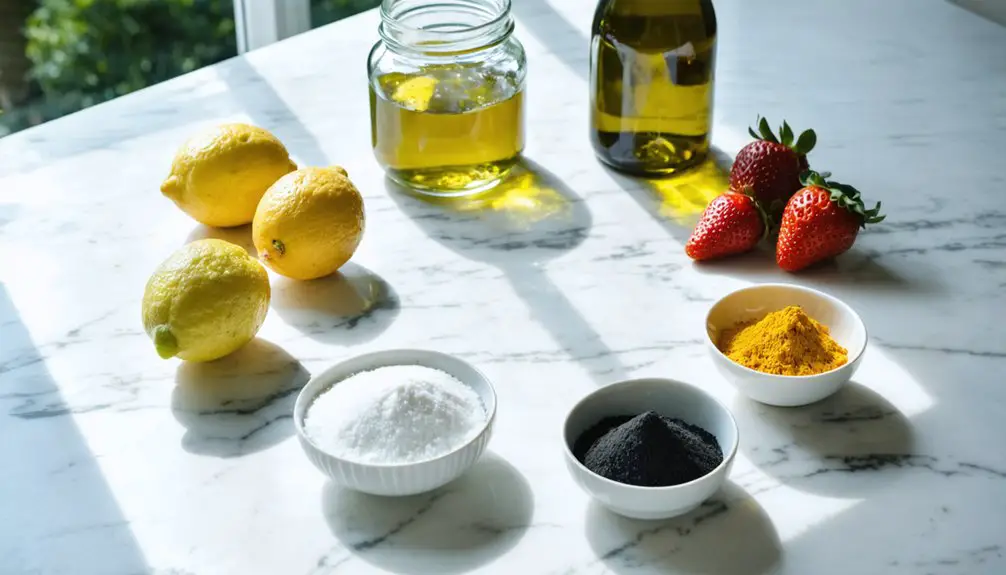You’ll find advanced LED technology in today’s top teeth whitening kits, which can brighten your smile up to 7 shades in just 5 days. Leading options include GLO Science’s heat-activated system, Crest 3DWhitestrips Sensitive + LED, and Colgate Optic White ComfortFit LED. These kits combine precise peroxide concentrations (3-10%) with blue wavelength activation, custom-fit applicators, and desensitizing agents. Professional-grade results now come at home prices ($50-300), with deeper analysis revealing which features match your specific needs.
Key Takeaways
- GLO Science Pro achieves 5-7 shade improvements in 5 days using heat-activated LED technology and custom-fit mouthpieces.
- Crest 3DWhitestrips Sensitive + LED Light combines gentle peroxide formulation with blue light acceleration for sensitive teeth.
- Colgate Optic White ComfortFit LED provides a 10-day treatment protocol with pre-measured gel doses and LED mouthpiece.
- Premium kits ($150+) with higher peroxide concentrations and LED technology deliver faster, more dramatic whitening results.
- Custom-fitted trays with LED activation ensure even gel distribution and optimal contact for professional-grade results at home.
Understanding LED Technology in Modern Teeth Whitening
While teeth whitening has evolved considerably over the years, LED technology now stands at the forefront of modern whitening solutions.
You’ll find LED Benefits include efficient activation of peroxide-based gels without heat emission, making it safer for your enamel while achieving noticeable results in just 30-60 minutes. Most treatments require 10 to 30 minutes of LED exposure for optimal results.
The Light Activation process works through blue or indigo wavelengths that trigger photochemical reactions in the whitening gel.
When the LED light hits the peroxide compounds, it accelerates the oxidation process, breaking down stubborn stains more effectively than gel alone.
You’re getting deeper penetration into both enamel and dentin layers, resulting in an average improvement of 4-5 shade units.
Unlike UV or laser systems, LED technology offers controlled intensity that won’t compromise your tooth structure or cause gum irritation.
Sessions typically cost between $250 to $500 for professional LED whitening treatments in the Kendall, Miami area.
Top Whitening Kits for Sensitive Teeth
When choosing a whitening kit for sensitive teeth, you’ll need products specifically formulated with lower peroxide concentrations and desensitizing agents.
For sensitive solutions, consider Crest 3DWhitestrips Sensitive + LED Light kit, which combines gentle hydrogen peroxide with an LED accelerator to remove decades of stains while protecting enamel integrity. The innovative system removes over 20 years of tough stains using specially formulated ingredients that won’t harm tooth enamel.
For peroxide-free whitening alternatives, Oral Essentials Lumineux offers natural ingredients that won’t trigger sensitivity. Professional monitoring of these treatments can help ensure safe whitening outcomes.
The Colgate Optic White ComfortFit LED system provides a 10-day treatment engineered specifically for comfort.
To maximize results while minimizing discomfort, limit application to 30 minutes daily, and incorporate desensitizing toothpaste like Sensodyne Extra Whitening into your routine.
Remember to follow manufacturer instructions precisely and allow periodic breaks between treatments to support enamel remineralization.
Comparing Active Ingredients and Their Effects
Understanding the active ingredients in teeth whitening kits helps you make informed decisions about which products will work best for your needs.
Knowledge of teeth whitening ingredients empowers you to select products that align with your specific whitening goals and concerns.
When conducting an active ingredient comparison, you’ll find hydrogen peroxide (3-10%) and carbamide peroxide (10-35%) as primary chemical whitening agents, while enzymatic compounds like bromelain offer gentler alternatives. The active ingredient peroxide opens the enamel matrix structure to effectively remove trapped stains.
A whitening effectiveness evaluation reveals that peroxide-based formulations deliver faster, more significant results by penetrating both enamel and dentin layers.
They’ll effectively break down organic stains, though higher concentrations require professional oversight. Modern LED light technology accelerates whitening results while maintaining safety.
Natural enzymes mainly target surface stains, working more gradually but with reduced sensitivity risks.
For peak results, consider delivery systems – custom-fit trays provide better contact with teeth than pre-filled strips, enhancing the active ingredients’ performance.
Proven Results and Clinical Studies
Clinical studies show that advanced at-home whitening technologies achieve comparable or superior results to in-office treatments, though they require considerably longer treatment durations.
You’ll find that higher-concentration products (like 20% carbamide peroxide) deliver more dramatic color changes but may increase tooth sensitivity compared to over-the-counter alternatives. A recent clinical trial found that at-home whitening with 20% carbamide peroxide produced significantly better color stability than over-the-counter systems.
GLO Science’s clinical trials demonstrate that their device produces 30% better whitening results than traditional strips after 10 days, with effects remaining stable for up to 30 days despite exposure to staining beverages.
The innovative system combines a specially formulated gel with a patented universal mouthpiece that uses gentle warming heat and blue LED light for optimal whitening.
Clinical Testing Benchmarks
Through rigorous scientific evaluation, teeth whitening products undergo extensive colorimetric analysis to validate their efficacy and safety. Clinical efficacy studies measure changes in tooth lightness (L*), redness (a*), and yellowness (b*) values, while sensitivity outcomes are tracked using Visual Analogue Scale assessments. Research shows that applying ozone after peroxide can significantly reduce tooth sensitivity while maintaining effective whitening results.
- Spectrophotometry testing reveals that professional-grade 20% carbamide peroxide treatments deliver superior color changes compared to OTC alternatives.
- Advanced 10% carbamide peroxide home systems achieve results comparable to 35% hydrogen peroxide in-office procedures.
- Higher peroxide concentrations accelerate whitening but increase tooth sensitivity risk, peaking between days 5-14.
- Six-month stability testing demonstrates maintained whitening results with professional-grade systems, while OTC products show significant color relapse.
Treatment Duration Vs Results
Recent clinical studies have demonstrated a complex relationship between teeth whitening treatment duration and measurable results, with advanced technologies reshaping traditional time-efficacy expectations.
You’ll find that advanced systems like GLO Science can achieve significant whitening (5-7 shades lighter) in just 5 days, with results remaining stable for 30 days despite exposure to staining beverages.
While conventional at-home treatments typically require 7 to 140 hours of total application time, new technologies incorporating heat activation and pH optimization have dramatically improved treatment speed without compromising whitening effectiveness. GLO Science’s commitment to clinically proven products, validated through multiple research publications and studies, reinforces the reliability of these accelerated whitening protocols.
The data shows that these shorter, more intensive protocols can match or exceed the results of longer treatments.
Clinical evidence indicates that following manufacturer-recommended durations optimizes shade improvement while minimizing sensitivity, whether you’re using a 5-day or 14-day protocol.
User-Friendly Features and Application Methods

Modern teeth whitening kits incorporate numerous user-friendly features that streamline the application process while maximizing safety and efficacy.
Today’s innovative whitening systems combine smart design with proven safety measures to deliver professional-grade results in the comfort of home.
You’ll find advanced designs that prioritize both comfort and results, whether you’re using pre-filled trays or LED-activated systems.
- Pre-measured gel doses eliminate guesswork and prevent overuse, while clear instructions and shade guides help you track your whitening progress effectively.
- LED-embedded mouthpieces combine light therapy with whitening agents, reducing treatment time while optimizing results through enhanced peroxide activation.
- Custom-fitted trays guarantee even gel distribution and minimize leakage, providing superior contact with your teeth compared to universal-fit options.
- Built-in safety features like auto shut-off timers and desensitizing agents protect your teeth and gums while maintaining consistent treatment protocols.
Price Points and Value Analysis
When selecting a teeth whitening kit, you’ll find significant price variations ranging from $20 budget options to $300 premium systems, with effectiveness generally correlating to cost and ingredient quality.
You can expect mid-range kits ($50-$100) to deliver measurable results of approximately 2.6 shades lighter within three weeks, while premium kits above $150 often accelerate results through professional-grade peroxide concentrations and custom-fit trays.
Your long-term investment considerations should account for maintenance treatments, replacement gels, and the potential need for desensitizing agents, which can add $30-60 annually to your initial kit purchase.
Investment vs. Expected Results
Understanding the correlation between investment and results in teeth whitening kits helps consumers make informed purchasing decisions.
When comparing investment benefits across price ranges, you’ll find distinct results patterns that align with technological sophistication and active ingredient concentrations.
- High-end kits ($100+) with 35% carbamide peroxide achieve up to 5 shades lighter within 7-10 days, offering custom trays and sensitivity protection.
- Mid-range options ($30-60) featuring LED technology and moderate peroxide levels deliver 2-3 shades improvement over 2-3 weeks.
- Budget kits (under $20) focus on surface stain removal, yielding 1-2 shades of improvement with simplified delivery systems.
- Long-term value improves with kits offering reusable components, refillable gels, and LED accelerators, though initial costs are higher.
Premium vs. Budget Options
Despite the allure of budget-friendly teeth whitening options, premium kits offer significant advantages through their superior materials, advanced technology, and clinically proven formulations.
Premium benefits include medical-grade plastics, optimized peroxide concentrations, and professional-grade LED lights with customizable settings that enhance whitening efficiency by up to 30%. You’ll find custom-fit trays ensuring even distribution and consistent results.
While premium kits range from $60 to $150+, their value lies in quality-controlled components and scientifically validated formulations.
Budget drawbacks often include basic LED technology, lower-quality materials, and generic application methods that may yield uneven results.
When considering long-term effectiveness and safety, premium kits’ superior construction, precise formulations, and advanced features justify the higher investment for those seeking professional-grade whitening results.
Long-term Cost Breakdown
Three distinct price tiers define the long-term investment in teeth whitening: professional in-office treatments ($500-1,000), dentist-prescribed kits ($200-400), and over-the-counter options ($10-55).
When performing a cost comparison across these options, you’ll need to factor in ongoing maintenance strategies and replacement costs.
- Professional treatments offer longest-lasting results (6 months to 2 years) with touch-ups costing $100-300 per session.
- Dentist-prescribed kits require $50-100 gel refills every few months but provide consistent results for up to one year.
- OTC products need more frequent replacement (every 6-12 months) due to lower potency, potentially increasing long-term costs.
- Advanced LED kits ($139) include 6-month supplies, with replacement costs matching initial investment but accelerating whitening results.
Safety Considerations and Best Practices
While teeth whitening kits offer effective at-home solutions for dental brightening, their safe use requires strict adherence to established protocols and precautions.
You’ll need to follow safety guidelines precisely, including recommended treatment durations and frequency, to prevent enamel damage and tooth sensitivity.
Before starting any whitening regimen, consult your dentist if you have restorations or oral health concerns.
You should always brush and floss before treatment, but avoid brushing four hours prior to reduce sensitivity risks.
Choose ADA-approved products from reputable manufacturers, and carefully read all instructions before beginning.
After treatment, rinse thoroughly and avoid staining substances for 48 hours.
Monitor for side effects and discontinue use if you experience persistent discomfort.
For best results and safety, maintain consistent oral hygiene practices throughout your whitening journey.
Frequently Asked Questions
Can I Drink Coffee Immediately After Using a Teeth Whitening Kit?
Like a fresh canvas needs time to dry, you shouldn’t have coffee consumption for 24-48 hours after whitening. Your teeth’s open enamel pores need time to close, preventing stains and teeth sensitivity.
How Long Do Teeth Whitening Results Typically Last Before Needing Touch-Ups?
Your whitening duration typically lasts 6-12 months under ideal conditions, but you’ll need touch-up treatments sooner if you consume staining foods/drinks regularly. Most people require touch-up frequency of 4-6 months.
Are Teeth Whitening Kits Safe to Use With Dental Crowns or Veneers?
While whitening kits won’t damage your dental work, they can’t whiten crowns or veneers. For ideal crown compatibility and veneer care, you’ll need professional alternatives to address color mismatches.
Can Teenagers Safely Use At-Home Teeth Whitening Kits?
With 13% hydrogen peroxide in many kits, you shouldn’t let teenagers use at-home whitening products. Their developing enamel’s vulnerability creates significant whitening sensitivity concerns and teenage dental safety risks.
Will Teeth Whitening Kits Remove Antibiotic Stains From Tetracycline Use?
You’ll find typical home whitening kits aren’t very effective on tetracycline stains since they’re deeply embedded in tooth structure. Professional treatments offer moderate improvement but require extended periods and won’t completely eliminate discoloration.
References
- https://www.tribecasmiles.com/best-teeth-whitening-kits-with-trays-2025
- https://www.youtube.com/watch?v=aHosC0H-JDk
- https://www.goodhousekeeping.com/health-products/g28723133/best-at-home-teeth-whitening-products/
- https://mysmilesteeth.com/blogs/mysmiles-blog/choosing-the-right-teeth-whitening-kits-a-global-guide
- https://g-p-dental.com/best-teeth-whitening-kits-in-2025-safe-option/
- https://artisticsmilesmiamidentist.com/blog/laser-teeth-whitening-vs-led-teeth-whitening/
- https://www.colgate.com.au/oral-health/teeth-whitening/how-does-led-teeth-whitening-work
- https://pmc.ncbi.nlm.nih.gov/articles/PMC3466022/
- https://www.trysnow.com/blogs/news/how-do-teeth-whitening-machines-work
- https://gloscience.com/blogs/blog/how-led-teeth-whitening-works



